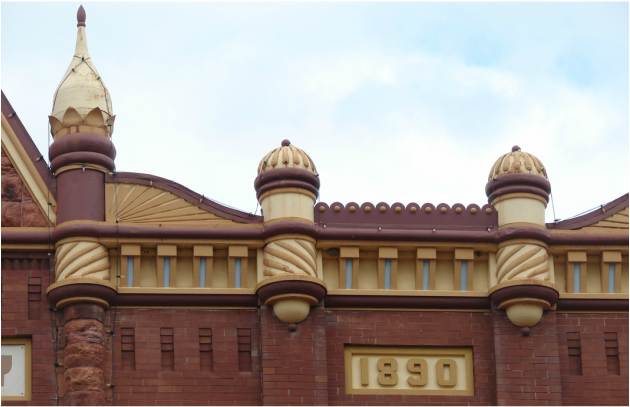|
Have you ever really looked at the detail on top of the commercial buildings in historic downtowns? Most of us, including myself until four years ago, haven’t. For seven years I was the Curator of the Old Cowtown Museum in Wichita, Kansas. Cowtown was not your typical museum, instead of a central building with exhibit cases we had 70 wooden structures with period exhibits. For years I kept looking at a number of unusual metal machines in the back of the Depot building. They were labeled tin machines, except they didn’t look like typical tin shop machines. Eventually curiosity got the best of me and I starting trying to research the machines. At first my research led nowhere, as I looked up tin machines and contacted museums with tin shop exhibits. No one could say with any certainly what we had. Eventually I discovered a similar picture in an historic catalog, in the sheet metal section. From there I started researching the sheet metal industry and machinery ,which led to my discovery of the Cornice Works Industry. Once I had a name and purpose I became more determined to understand. What exactly did these machines do? How did they work? I learned that metal cornices became popular between 1880-1910 because they were cheaper than stone decoration, came in many styles, were easy to ship and install, and could be painted to look like more expensive stone. However, the Cornice Works industry was short lived and sometimes existed as sub-industries of larger sheet metal manufacturing businesses, making it difficult to research. I also discovered that the machines in front of me came from Buckley Industries which evolved from the Eagle Cornice Works Shop founded in 1885, in Wichita, KS. The company, specialized in galvanized window cornices, window caps, dormer windows, tin, iron, and slate roofing. Their cornices were shipped to towns in Kansas, Oklahoma, Colorado and Texas. About this point I starting wondering how many metal cornices still exist? In Wichita, most of the downtown buildings have stone details, but the metal detail produced by the Eagle Cornice Works remained on the Sedgwick County Court House, Friends University, and Wichita State University. So my patient and equally curious husband, Mark and I started driving. It turns out that many smaller towns still have many of their original metal cornices intact. So far we have photographed cornices in Kansas, Oklahoma, and Missouri. Some of the cornices are plain while others are very ornamental. Some have been freshly painted, some are in disrepair, while others are gone entirely leaving an empty slightly sloped brick edge where a cornice was once attached. Historic photographs often show the cornices in their original glory, but what can be done today if a piece is missing? At some point I stumbled upon a modern online cornice catalog for the W. F. Norman Company in Nevada, Missouri. They are still in business today using the original cornice machinery from the 1890s. They have kept every mold of every cornice they have ever produced making them the source for replacement cornice parts. They even do tours of the facility by appointment, so of course Mark and I went on another road trip. We could have stayed all day, watching the processes in action. Many of the employees have been there forever and are still learning. They do punched metal, metal rolling and cutting, and metal spinning. They will make custom replacement parts through trial and error till the result is perfect. After all of this there is still a machine that remains unidentified. Maybe it’s missing a piece, maybe one day it will identified; maybe it won’t. I opened the Eagle Cornice Works exhibit at Cowtown in Spring of 2012. The same year Mark got a new position as Director of the Museum Studies Program at UCO. When we selected a new community to move to, the cornices helped lead the way to Guthrie.
2 Comments
Leave a Reply. |
AuthorThis blog was created by Amy Loch to share stories of experiential history in and connected to Logan County. Archives
August 2016
Categories |
Logan County Historical Society
P. O. Box 1512 Guthrie, OK 73044
melissa.trolley@yahoo.com
405-282-6000 ex 6
P. O. Box 1512 Guthrie, OK 73044
melissa.trolley@yahoo.com
405-282-6000 ex 6
@2016 Logan County Historical Society

 RSS Feed
RSS Feed